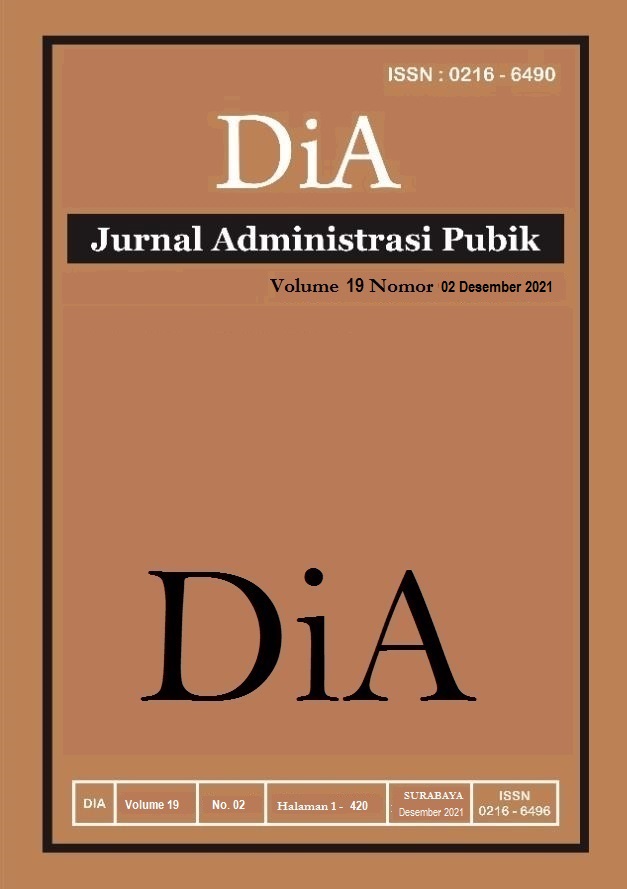THE INFLUENCE OF FLEXIBLE WORKING PLACE AND FLEXIBLE WORKING TIME ON JOB SATISFACTION WITH WORK-LIFE BALANCE AS A MEDIATING VARIABLE ON COVID-19 PANDEMIC
DOI:
https://doi.org/10.30996/dia.v19i2.5316Keywords:
Covid-19, Pandemic, Work-Life Balance, Job Satisfaction, Flexible workingAbstract
The aim of this study is to analyze the relation between the flexible working place and flexible working time on job satisfaction, directly or indirectly, with the itervention of the work-life balance as a mediating variable. This research is conducted to a civil servant and a non civil servant/contract-based staff in Indonesian Financial Transaction Reports and Analysis Center (INTRAC). Furthermore, the quantitative approach is used in this research. The data is collected by distributing a questionnaires to 148 respondents and being analyzed with Smart PLS program/application version 3.0 with Sem PLS method. The results concludes that both variables which are flexible working place and flexible working time makes a positive and significant effect on job satisfaction variable. Furthermore the flexible working place and flexible working time on job satisfaction with work-life balance as a mediating variable also have a positive effect. The results of this study explain that the implementation of flexible working place and flexible working time can be said to be successful and has a positive effect on job satisfaction because there is an increase in a work-life balance felt by employees of the Indonesian Financial Transaction Reports and Analysis Center (INTRAC)
Downloads
References
Adiningtiyas, Nurul. (2016). Work Life Balance Index Among Technician. Universitas Mercubuana, Jakarta. Jurnal Ilmu Ekonomi dan Sosial, Volume 5 Nomor 3.
Baltes, B.B., Briggs, T.E., Huff, J.W., Wright, J.A. and Neuman, G.A. (1999). Flexible and compressed workweek schedules: a meta-analysis of their effects on work-related criteria, Journal of Applied Psychology, Vol. 84 No. 4, p. 496.
Basol, O. (2016). Classic or modern? Enhancement of job satisfaction scale for green job workers. Management. (18544223), 11(2), 103-122.
Batura, N., Skordis-Worrall, J., Thapa, R., Basnyat, R., & Morrison, J. (2016). Is the job satisfaction survey a good tool to measure job satisfaction amongst health workers in Nepal? Results of a validation analysis. BMC Health Services Research
Brayfield, A. H., & Rothe, H.F., (1951). An Index of Job Satisfaction. Journal of Applied Psychology. 35, 307 – 311.
Cammann, C et, al,. (1979). Job Satisfaction Subscale of the Michigan Organizational Assessment Questionaire.
Davidescu, Adriana AnaMaria et al,. (2020). Work Flexibility, Job Satisfaction, and Job Performance among Romanian Employees-Implications for Sustainable Human Resource Management. MDPI Journals of Sustainability, 12, 6086.
Duta Mustajab, A. B. (2020). Working From Home Phenomenon As An Effort To Prevent COVID-19 Attacks And Its Impacts On Work Productivity. The International Journal Of Applied Business, 13-21.
Fisher, G.G. (2002). Work/Personal Life Balance: A Construct Development Study. Dissertation Abstracts International: Section B. The Sciences and Engineering, 62(1), 575
Gagne, Marylene. (2007). Validation Of The Satisfaction With Work Scale. Ecole Nationale d’Administration Publique.
Gajendran, R. S., and D. A. Harrison. (2007). The Good, the Bad, and the Unknown About Telecommuting: Meta-Analysis of Psychological Mediators and Individual Consequences. The Journal of Applied Psychology.
Gunawan, Gianti. (2019). Reliabilitas dan Validitas Konstruk Work Life Balance. Universitas Padjajaran. Jurnal Penelitian dan Pengukuran Psikologi (JPPP).Vol 8 No 2.
Malik, A., Rosenberger, P.J., Fitzgerald, M. and Houlcroft, L. (2016). Factors affecting smart working:mevidence from Australia. International Journal of Manpower, Vol. 37 No. 6, pp. 1042-1066
Messenger, J. C., and L. Gschwind. (2016). Three Generations of Telework: New ICTs and the Rvolution from Home Office to Virtual Office. New Technology, Work and Employment.
Ritter, Monique de. (2020). Working At Home Practices During the COVID-19 Crisis. Frankfurt. M&L Communication Marketing.Work Environment and its Effects On Job Satisfaction in Coperative Sugar Factories in Maharashtra India.
Sang, Choi, et al. (2014). The Impact of transformational leadership Style on Job Satisfaction.
Semlali, S., & Hassi, A., (2016). Work-life balance: how can we help women IT professionals in Morocco?. Journal of Global Responsibility, 7(2), 210-225.
Spector, E. Paul. (1997). Job Satisfaction; Application, Assessment, Causes, and Consequences. Sage Publication, Inc.
Tabancali, E. (2016). The relationship between teachers job satisfaction and loneliness at the workplace. Eurasian Journal of Educational Research.
Thompson, R.J., Payne, S.C. and Taylor, A.B. (2015), Applicant attraction to flexible work arrangements: separating the influence of flextime and flexplace, Journal of Occupational and Organizational Psychology, Vol. 88 No. 4, pp. 726-749.
Downloads
Published
How to Cite
Issue
Section
License
The DiA journal allows authors to retain the copyright of their papers without limitation. Authors may grant publishers non-exclusive publishing rights to publish articles. Granting first publishing rights to publishers also qualifies as unlimited copyright (because there are no restrictions imposed by publishers on author copyright).







